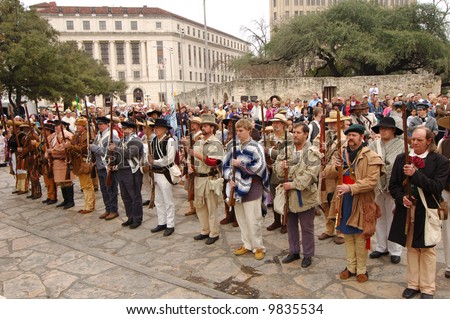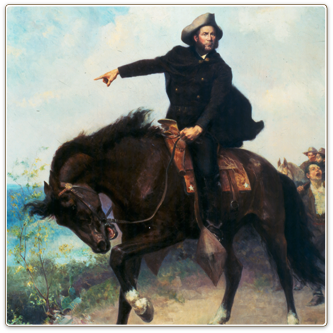All good Texans will tell you February 23rd was “a day that will live in infamy.” All good Tejanos will tell you it’s a day when a bunch of invaders got really stupid.
 I arrived in San Antonio to find the city abuzz with activity. Okay, not the whole city. Just a tiny area around the Alamo. Reenactors, dressed in mismatched 1836 frontier outfits, carrying muzzle-loading muskets, were marching into the Alamo. They were reenacting the siege of the Alamo that resulted in their deaths and the eventual separation of Texas from Mexico thirteen days later.
I arrived in San Antonio to find the city abuzz with activity. Okay, not the whole city. Just a tiny area around the Alamo. Reenactors, dressed in mismatched 1836 frontier outfits, carrying muzzle-loading muskets, were marching into the Alamo. They were reenacting the siege of the Alamo that resulted in their deaths and the eventual separation of Texas from Mexico thirteen days later.
February 23rd is the first (as Texans would have it) of the “13 days to Glory.” It triggered, as history always does, a series of events that would change Mexico, the United States—North, South, East and West—and certainly the fate of Texas. The cascade of problems would not end for a hundred years.
Why? In 1834, the conservative Centralists in Mexico had begged Santa Anna to switch sides (he had been a liberal president in 1832). They needed his help to save them from the liberal constitution established ten years earlier. Santa Anna, always ready to lead his nation and justifiably concerned over the problems caused by a weak central government, agreed. Even if it meant changing constitutions.
With the help of the Centralists, Santa Anna created the very conservative Constitution of 1834. It stripped the states of their rights (much as the US Constitution of 1789 did), but without any Federalist Papers or begging or cajoling. He simply imposed it and let the chips fall where they may. Not everyone was happy. Especially not states-rights liberals.
Several Mexican states, Zacatecas in particular, went up in revolt. So did Texas. Santa Anna marched on Zacatecas and devastated the rebels, massacring any who had dared revolt. Word got back to Texas and the call went out to the United States for help. Promised huge grants of free land, it is not surprising that hordes of “pirates, filibusters and ne’er-do-wells” flocked to Texas to help against “the invader.” Considering it was Santa Anna’s own country, his movements could hardly be called an invasion.
Santa Anna sent his brother-in-law, General Cos, to settle things in Texas. Most of the people in Texas liked having control over the sale of their lands (always look for the money). The combined forces of both Tejanos (those Texans of Mexican descent) and Texians (most of whom had flocked to Texas from the U.S. to receive the nearly free grants of almost 5,000 acres of land), successfully defeated the small Mexican army in December of 1835. Together they ran General Cos back to Mexico. Embarrassing Santa Anna.
By January of 1836, Santa Anna notified Texans that he was coming. He assured the populace that he did not aim to harm anyone who had not rebelled. Remembering Zacatecas, however, most Texas settlers stayed out of the way, or tried to.
According to historian Paul Lack, 90% of the rebel army in Texas was made up of outsiders. Between 180 and 250 of them holed up in the Alamo in San Antonio. The mission, once San Antonio de Valero, had been secularized and taken over by the military unit from Alamo de Parras in northern Mexico, hence the name, Alamo. Outsiders William Travis, David Crockett, and even Daniel Boone and their 180-plus companions, thinking to stop Santa Anna’s nearly 2,000 men, settled in.
 Here there is a difference of opinion. Some say Sam Houston, having been placed in control of the rag-tag army of outsiders, and waiting at Gonzales many miles away, ordered William Travis and David Bowie to abandon the Alamo. He needed them to join him at Washington-on-the-Brazos so they could make a united front against the larger Mexican army. They chose not to.
Here there is a difference of opinion. Some say Sam Houston, having been placed in control of the rag-tag army of outsiders, and waiting at Gonzales many miles away, ordered William Travis and David Bowie to abandon the Alamo. He needed them to join him at Washington-on-the-Brazos so they could make a united front against the larger Mexican army. They chose not to.
So that brings us to February 23rd and the arrival of the Mexican President to put down an incipient revolt. The men in the Alamo were, after all, mostly illegal aliens disobeying the legally constituted government. General Santa Anna warned those in the fort with a red flag over the church and the trumpet call of the Ðeguello – the order to execute all prisoners—that he would have no mercy. Thirteen days later, he didn’t.
The Alamo, and the death of its defenders, provided a great rallying call for Sam Houston. Gathering troops and hoping to gain help from the U.S., he backed toward the border. On April 21st, in a stunning upset, Sam Houston defeated and captured a shocked Santa Anna at San Jacinto and massacred his Mexican troops. Sam forced him to sign away Texas.
According to Tejanos, the Alamo, now misnamed the ‘cradle of liberty’ and misinterpreted as a ‘defense of freedom’ by the eventual victors has become a ‘shrine’ visited by thousands. Tejanos, many of whom who also fought for Texas, are given short shrift and written out of the histories. Except mine (see De Leon: A Tejano Family History).
The results?
The Texas Republic,
which triggered the Mexican-American War,
which triggered the acquisition of the entire Western U.S.,
which triggered the Civil War,
which triggered the destruction of the South,
which triggered the growth of the Northeast, etc., etc., etc.
Don’t you just love the changing views of history?

… [Trackback]
[…] Find More Info here on that Topic: carolinacastillocrimm.com/tidbits-from-history-at-the-alamo/ […]
… [Trackback]
[…] Read More on on that Topic: carolinacastillocrimm.com/tidbits-from-history-at-the-alamo/ […]
… [Trackback]
[…] Find More Information here on that Topic: carolinacastillocrimm.com/tidbits-from-history-at-the-alamo/ […]
… [Trackback]
[…] Find More Information here on that Topic: carolinacastillocrimm.com/tidbits-from-history-at-the-alamo/ […]